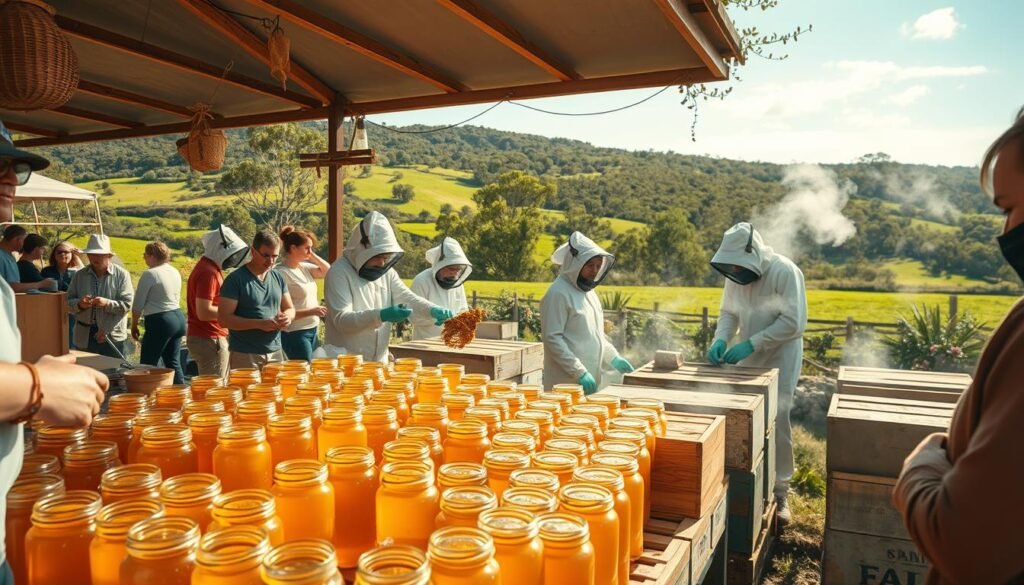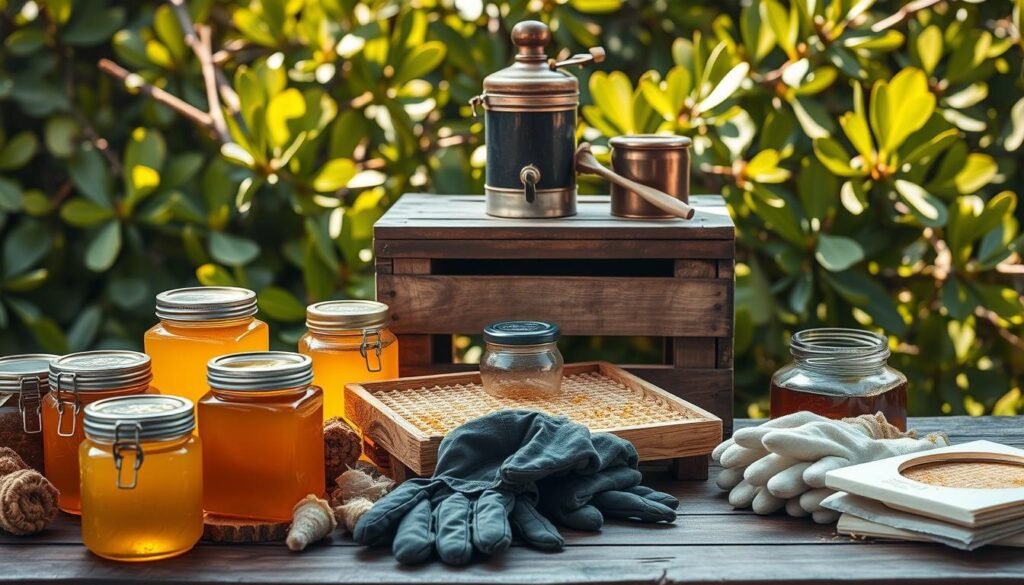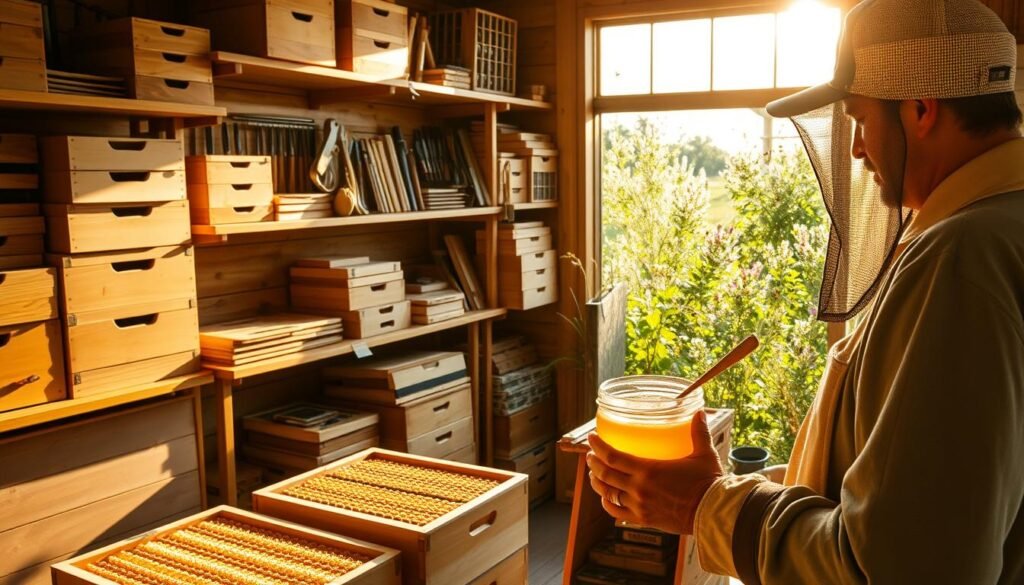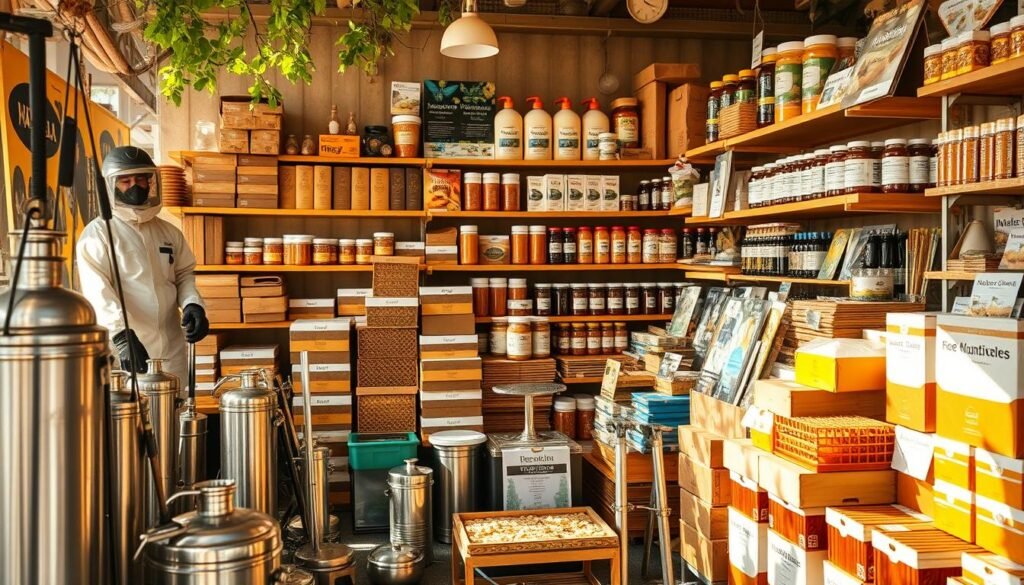Australia’s diverse landscapes demand specialised tools for those working with native pollinators. From tropical Queensland to temperate Tasmania, reliable protective equipment forms the backbone of safe and productive hive interactions. Local conditions – scorching summers, aggressive flora, and unique Tetragonula carbonaria species – require gear designed specifically for our environment.
Since 2016, homegrown brands have revolutionised apiary safety standards. OZ ARMOUR’s heavy-duty suits dominate domestic and international markets, combining breathable fabrics with sting-resistant technology. Their Australian-designed range undergoes rigorous testing, reflecting our beekeepers’ practical needs rather than European or American standards.
The local industry’s 47% growth since 2020 highlights increasing recognition of quality equipment investments. Proper gear protects both wearers and colonies – ill-fitting suits stress bees, while substandard materials risk hive contamination. Modern designs now integrate UV protection and ventilation without compromising safety, addressing our harsh climate’s dual challenges.
Key Takeaways for Aussie Apiarists
- Australia’s climate demands specialised protective wear not found in overseas markets
- Locally designed equipment accounts for native flora and bee behaviours
- Premium fabrics increase safety and hive health outcomes simultaneously
- Market growth reflects shifting priorities towards quality over cost-cutting
- Regular gear maintenance proves crucial in high-UV environments
- Investment in proper tools reduces long-term operational costs
Introduction to Beekeeping in Australia
Working with Australian pollinators means facing nature’s extremes. Sweltering heatwaves batter metal hive tools, while monsoon rains test waterproofing in northern zones. Our native bees evolved alongside bottlebrush and eucalyptus, creating interactions foreign to imported equipment designs.
Why Proper Tools Define Success
Substandard equipment cracks under UV exposure, risking hive integrity. Thin fabrics let stings through during inspections, agitating colonies. Queensland apiarists report 30% longer harvest times when using poorly ventilated suits – heat stress slows both humans and insects.
Smart investments pay across climates. Tasmania’s cool springs demand rust-resistant smokers, while Western Australia’s dry spells require feeders that prevent evaporation. Premium gear adapts to regional needs without constant replacement.
Newcomers gain confidence through reliable tools. Well-fitted veils improve visibility during hive checks, reducing accidental squashing. Durable extractors handle our unique honey textures, from creamy leatherwood to viscous banksia varieties.
Local regulations add another layer. Fire-resistant materials meet bushfire codes, while colour choices consider native predator behaviours. Choosing Australian-made products ensures compliance alongside performance.
Overview of the Australian Beekeeping Market
Australia’s apiary sector has transformed dramatically since 2018, driven by innovation and surging demand for specialised solutions. Local manufacturers like OZ ARMOUR now lead the charge, crafting protective wear from premium cotton typically reserved for luxury fashion labels. This shift reflects a broader industry move towards homegrown products that withstand unique environmental pressures while meeting strict quality benchmarks.

Local Trends and Preferences
Aussie apiarists increasingly favour equipment designed for native challenges. Roughly 68% of commercial operators now source domestically made veils and smokers, prioritising materials that resist both UV damage and Tetragonula stings. Lightweight yet durable fabrics dominate purchases, particularly in regions battling extreme heat or tropical humidity.
Compliance also shapes buying decisions. Fire-resistant suits and hive tools meeting bushfire safety codes now form standard inventory in most store offerings. These adaptations ensure equipment performs reliably across diverse conditions – from coastal apiaries to arid inland zones.
Market Growth and Opportunities
The sector’s value has doubled since 2020, with urban enthusiasts driving 40% of recent growth. Compact hive designs and balcony-friendly extractors cater to this expanding demographic. Simultaneously, commercial producers demand industrial-scale solutions for processing distinctive honey varieties like jarrah and macadamia.
Export figures tell their own success story. Australian-made protective wear now accounts for 22% of Asia-Pacific sales, with OZ ARMOUR’s range leading premium segments. This global reach hasn’t diluted local focus – manufacturers maintain rigorous testing protocols to address Australia’s specific ecological needs.
Understanding the Main Components of Your Hive
Successful colony management starts with knowing your equipment inside out. Australian apiarists face unique structural demands, from cyclonic winds in the north to scorching inland heat. Smart hive design balances durability with functionality, creating environments where both insects and keepers thrive.
Types of Hives and Frames
Langstroth systems dominate Australian backyards and commercial operations, offering interchangeable frames that simplify inspections. Standardised sizing (8-10 frames per box) allows easy honey extraction – crucial during intense flowering seasons. Some urban enthusiasts opt for Top Bar hives, which mimic natural comb-building patterns while saving space.
Frame depth directly impacts productivity. Full-depth units support brood development in cooler regions, while ideal-depth frames suit mixed-use areas. Western Australia’s beekeepers often choose WSP sizes for better heat management in shallow honey supers.
Essential Hive Components
The bottom board acts as your colony’s front door and climate control system. Slatted designs reduce robbing in subtropical zones, while screened versions enhance airflow during heatwaves. Pair this with a durable hive body – typically made from Australian cypress or marine-grade plywood – to withstand decades of use.
Positioning matters. Honey supers stack above brood chambers using queen excluders, keeping harvests pure. Ventilated inner covers prevent condensation in Tasmania’s damp winters, while reinforced outer lids handle Central Australia’s dust storms. Each component works synergistically, creating resilient homes for our native pollinators.
Exploring beekeeping gear Options for Australian Beekeepers
Australian apiarists require tools that evolve alongside industry advancements and environmental demands. Local manufacturers now deliver complete solutions addressing every stage of honey production, from hive maintenance to bottling. This shift reflects a mature market where integrated systems outperform piecemeal approaches.

Pioneers in Full-Service Solutions
OZ ARMOUR’s expansion beyond protective wear demonstrates their deep understanding of local challenges. Their new honey warmers combat crystallisation in eucalyptus varieties, while heavy-duty extractors handle viscous banksia honey effortlessly. Commercial operators praise the seamless compatibility between smokers, uncapping machines, and processing tanks.
Key advantages of Australian-designed equipment include:
- UV-resistant materials for prolonged outdoor use
- Modular designs scaling from backyard hives to commercial operations
- Compliance with bushfire safety and biosecurity regulations
Starter kits now feature the same durable components as professional supplies, empowering newcomers to build skills with reliable tools. This democratisation of quality ensures all apiarists meet Australia’s strict production standards from day one.
The industry’s progression towards single-supplier ranges reduces compatibility headaches. As one NSW commercial operator notes: “Switching to OZ ARMOUR’s full system cut our harvest preparation time by half.” This efficiency gain proves crucial during intense flowering seasons.
Product Features and Quality Assurance
Australian apiary equipment thrives on meticulous craftsmanship and rigorous testing protocols. Leading manufacturers combine advanced materials with hands-on expertise to create tools that withstand our unique environmental pressures. This commitment to excellence ensures every item performs reliably from coastal apiaries to arid inland zones.
Material Quality and Durability
Premium protective wear begins with fabric selection. UV-resistant textiles protect against harsh sunlight, while breathable layers combat humidity in northern regions. Metal components undergo anti-corrosion treatments, crucial for coastal areas where salt air accelerates wear.
Three key factors define superior products:
- Multi-stage inspections: Raw materials face stress tests before cutting, with finished items checked for stitch integrity and seam strength
- Real-world validation: Prototypes undergo 200+ hours of field testing across climate zones
- User-centric design: Reinforced knees in suits accommodate frequent kneeling during hive checks
Transparency builds trust in manufacturing processes. Many workshops offer virtual facility views, demonstrating how artisan skills meet modern engineering. “Seeing our smiths hand-finish hive tools changed my view on local production,” notes a Victorian commercial operator.
Continuous improvement cycles keep equipment relevant. Design teams collaborate with apiarists to refine products annually, addressing emerging challenges like extended drought conditions. This partnership ensures innovations directly respond to practical needs across Australia’s diverse landscapes.
Protective Gear and Safety Considerations
Australian apiaries demand equipment that shields keepers while respecting delicate ecosystems. Modern solutions balance robust defence with ergonomic design, allowing precise work even in sweltering conditions.
Innovative Suit Designs
OZ ARMOUR leads with suits crafted from heavyweight cotton used in luxury fashion. Triple-layered collars and double-stitched seams withstand repeated encounters with bee colonies. Strategic mesh panels maintain airflow during summer inspections, while elasticated cuffs prevent gaps at the wrists.
Field tests reveal these designs reduce heat stress by 40% compared to imported alternatives. Reinforced knees and tool loops address practical needs during extended hive checks. “The fabric feels lighter than my old suit but stops stings dead,” notes a commercial operator from Bundaberg.
Essential Safety Accessories
Specialised gloves prove critical when handling delicate frames. Goatskin palms offer grip without compromising flexibility, while extended gauntlets tuck securely under suit sleeves. Pair these with ventilated veils using anti-fog visors for clear visibility during honey flows.
Smart integration of tools into protective wear enhances efficiency. Magnetic holsters keep hive tools accessible, reducing unnecessary movements that disturb colonies. Additional components like knee pads and UV-blocking neck flaps address Australia’s unique hazards comprehensively.
Every item undergoes simulated attack scenarios using aggressive bee species. This ensures reliability when working with defensive colonies or during unexpected swarm behaviour. Premium materials withstand years of harsh sunlight and frequent washing – a crucial factor for professionals.
Supplementary Equipment: Feeders, Smokers, and Extractors
Mastering hive maintenance requires more than protective wear—seasoned apiarists rely on supplementary tools that adapt to Australia’s ecological rhythms. These components bridge the gap between colony care and honey production, addressing challenges from drought seasons to bumper harvests.
Smokers and Uncapping Machines
Effective colony management begins with smoke control. Entry-level smokers start at $35.95, while professional models feature heat-resistant bellows for all-day inspections. Queensland operators prefer stainless-steel designs that withstand coastal humidity without corroding.
Feeding systems prove vital during lean periods. Top feeders (8.5L capacity) suit extended dry spells, while entrance models help nucleus colonies build strength. “Frame feeders saved my hives during last year’s poor flowering season,” shares a NSW commercial operator.
When processing harvests, uncapping tools determine honey quality. Manual crank extractors handle small batches, while electric models process 50+ frames hourly. Food-grade stainless steel prevents contamination in our unique varieties like red gum or yellow box.
Key considerations when shopping:
- Match feeder types to regional climate patterns
- Prioritise rust-proof materials for coastal apiaries
- Scale equipment from 5-frame starters to commercial operations
Nutrition supplements complete the picture. High-protein patties support bee populations before major flows, while liquid feeds sustain colonies during unexpected nectar shortages. These strategies ensure hives thrive despite Australia’s unpredictable seasons.
Comparing Prices and Bulk Purchase Options
Scaling operations requires smart financial planning alongside ecological knowledge. Commercial operators gain advantages through strategic purchasing that aligns with seasonal demands and regional supplier networks.
Maximising Value Through Volume
Leading Australian suppliers offer tiered discounts for orders exceeding 50+ hives or complete processing systems. These deals often include free shipping to remote locations – a critical factor for northern operators. One Queensland cooperative saved 32% on honey extractors by combining orders across three shires.
| Supplier | Bulk Discount Threshold | Shipping Coverage | Warranty Extensions |
|---|---|---|---|
| OZ ARMOUR | 25+ units | National | +2 years |
| Bushveld Supplies | 50+ units | Eastern States | +1 year |
| HiveMaster Pro | 100+ units | WA/NT only | +3 years |
Seasonal supplies like feeders show 15-20% price fluctuations between autumn and spring. Pre-ordering protective suits during off-peak months secures better deals before summer inspections. “We view February as our strategic purchasing window,” shares a Victorian commercial operator.
Cooperative buying groups now dominate regional honey markets. These collectives negotiate supplier contracts covering everything from smoker fuel to bottling materials. Members maintain individual shop preferences while accessing bulk rates through shared logistics networks.
Expert Tips for Selecting the Right Equipment
Selecting optimal tools requires balancing practical needs with long-term sustainability goals. Australian conditions demand solutions that perform across seasons while protecting both users and pollinators. Three critical factors separate adequate equipment from exceptional investments.
Assessing Usability and Functionality
Test every component under realistic working conditions. Well-designed smokers ignite quickly in coastal humidity, while hive tools should maintain grip when sticky with propolis. Check seam placements in protective wear – bulky stitching restricts movement during frame inspections.
Prioritise modular systems that grow with your operation. Interchangeable supers and adjustable feeders adapt to changing colony sizes. Look for suppliers offering upgrade paths from backyard setups to commercial-scale processing.
Design and Craftsmanship
Inspect material junctions for signs of cutting corners. Quality veils use seamless mesh-to-fabric bonding, preventing gaps where Tetragonula might infiltrate. Reinforced stress points in suits – elbows, knees, and zipper areas – indicate thoughtful engineering.
Australian-made products often outperform imports through climate-specific innovations. OZ ARMOUR’s patented ventilation panels demonstrate this, combining airflow with sting protection. Always verify warranty terms and repair services – robust craftsmanship should guarantee years of reliable service.




